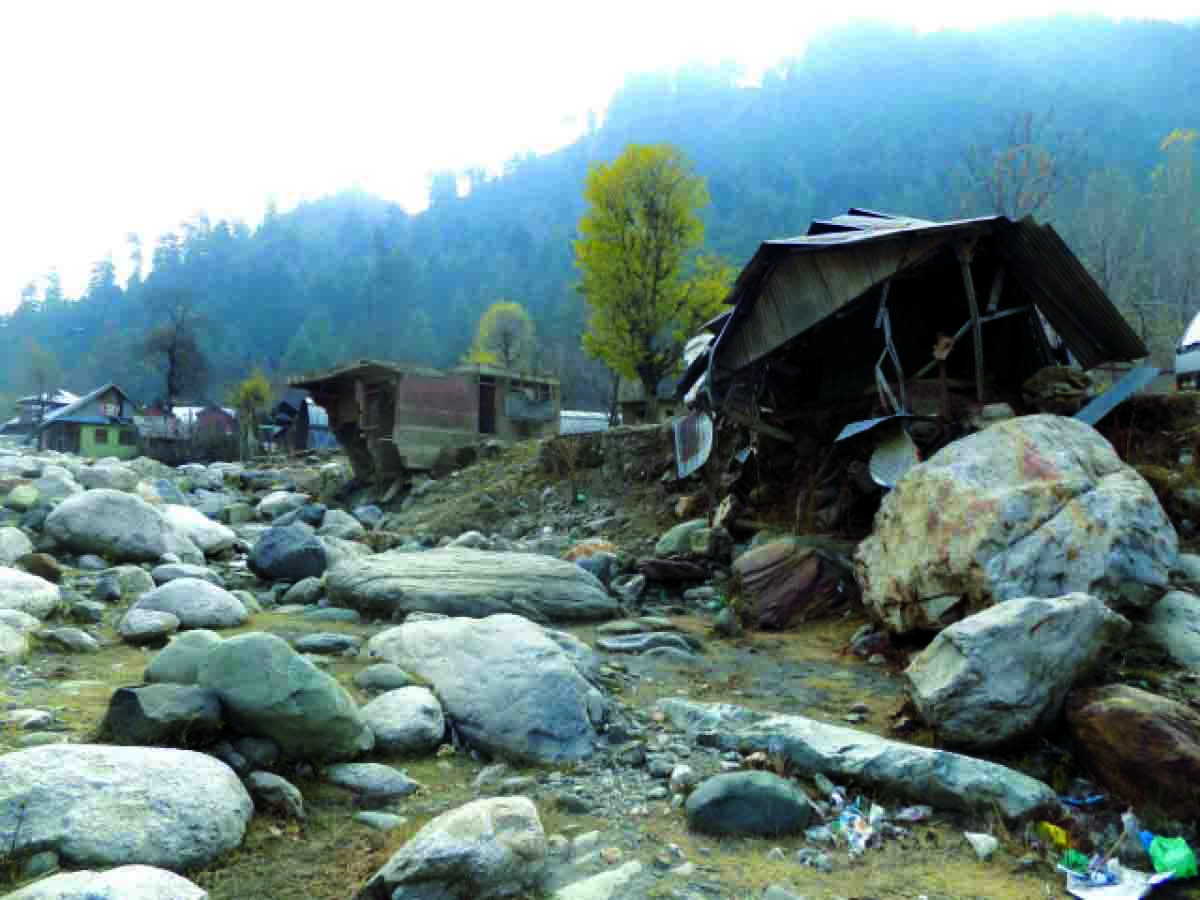A small village that lived on the banks of a torrent witnessed a literal change in its geography after 2014 floods devoured most of the land and the homes, Faheem Mir reports

Baila falls in Uri’s Boniyar belt, almost 25kms from Baramulla. It is a picture-perfect village with beautiful sceneries, fresh and cool water and air, evergreen forests and a roaring rivulet playing music round the clock.
But September 5, 2014, floods changed its geography forever. It was hit by devastating flood exactly two days earlier than Srinagar city.
Floods decimated the village, destroying the property, crops and livestock. Communication links, roads and bridges were damaged too. It took away its land, the main source of the income, as well.
Sajad Ahmad Khan, 30, is busy in removing small stones from a piece of land near his house to make it cultivate again. “I am trying to clear sand and stones to make it able to produce vegetables again and I am into the third year of making the efforts,” he said.
The only difference between the rest of Kashmir and this village was that unlike Jhelum that destroyed most of Kashmir, this village was devastated by the Hapatkhaie, a fast flowing rivulet flowing by the western side of the village.
As many as 19 residential houses, a Masjid, government primary school, Panchayat Ghar and a Fisheries farm were washed away. There was no human loss, however. Almost 90 percent area of the village was destroyed. “People here in this village were mostly dependent on agriculture but floods changed everything,” Nooruddin Khan said.
“It was exactly 6:30 am when we heard hue and cry in the village. I rushed outside to see what happened, I was surprised to see the water has entered the village,” Shakeela Bano, who is still frightened of that sight, said. “It was so horrifying, I asked my mother to leave the house immediately and we moved towards a nearby hillock to save our lives”.
It was still raining. Bano remembers the entire family getting drenched in the rain following which she volunteered to get some clothes from her home. “Water was moving slowly into the village but once we got into the home, the speed surged massively,” Bano said. “We somehow managed their escape and entered into an army camp where 12 of us spent 16 hours.” Tragically the army camp was itself inundated and the soldiers were crying for help. It was after those painful 16 hours that the adjoining villages came and rescued the civilians and the soldiers.
“They tied tightly a rope with an iron pole on the other side of the river and passed it over. By doing this we crossed the river by using the chair as a lift,” Shakeela recalls. “We spent two days outside on the hillock during those rainy days,” Rafiq Khan said.
The fisheries farm became the first victim of the river “Water washed away everything that came its way,” Shabir Khan said. “My house got invisible within minutes; nearly 70 percent of buildings were washed away.”
The floods helped the Hapatkhaie change its direction and it devastated everything to dictate a new course. It included approximately 200 kanals of agricultural land which was the only source of income for the villagers.
“Than God, my house stayed safe during the floods but nearly 10 kanals of land was washed away by water which we were using to grow paddy and maize crops,” Sajad Khan said.
After 2014, this village has no agricultural activity because there is no land. “I am working as a daily wager after losing my property, now I am visiting other places daily to earn a livelihood,” Sajad said. “There is no other source of income for my family.”
After a weeklong inundation, the villagers returned to the village to identify their piece of land. They rarely could because geography had changed. The village now presents a deserted picture. “Agricultural land turned into desert, green paddy plants were uprooted by water and replaced by rocks and sand,” Ghulam Mohammad Khan said.
Mukhtara Begum said when they came back and entered their village and after clearing the debris they found their homes full of dead fish.
Bano said they have a huge number of poplar trees and were in the process of selling it for around Rs 50 lakh. “We lost that all,” she said.
Help was modest and came from the government as well as the private charities. The government gave compensation of Rs 4 lakhs for fully damaged houses. Kashmir Welfare Trust constructed three-room houses for the flood affected families: 16 sets, each comprising two rooms, one kitchen and one bathroom.
Mukhtara Begum and Sajad said those families whose houses were damaged partially were not helped. Residents said the government is not helping them in retrieving the land surrounding the village so that they could start cultivating it.














